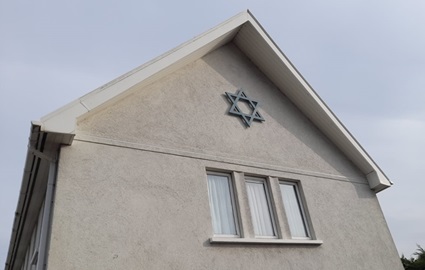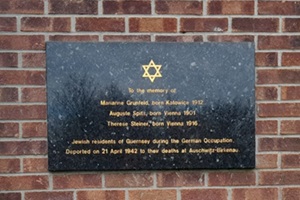| |
|
THE JEWISH COMMUNITY ON THE CHANNEL ISLANDS
The Channel Islands
The Channel Islands are a group of islands in the English
Channel, off the coast of Normandy, France. They comprise two separate political
entities, the Bailiwick of Guernsey (which also includes a number of smaller islands)
and the Bailiwick of Jersey. Although they are not technically part of the
United Kingdom (they do not send representatives to the Parliament in
Westminster), they are British crown dependencies.
The Jewish Community
It is most
probable that there were Jews in the Channel Islands in the Medieval period, in
light of their proximity to the French mainland and that fact the islands formed
part of the Duchy of Normandy, which had a significant Jewish population,
particularly in the city of Rouen (from where the medieval Jewish community in
England is believed to have originated). However, no evidence remains of the
medieval Jewish presence on the islands.
There were Jews in the Channel Islands
from at least the mid-eighteenth century,(i) although it was not until the 1840s
that a congregation was formally established, on the island of Jersey.
Although this congregation was defunct by about 1870, a number of Jews continued to reside on both
Jersey and Guernsey, and continued to hold religious services in private homes.
From 1940 until
1945, the Channel Islands were under Nazi German occupation, being the only British territory to be
occupied by Germany during World War II,
and the few Jews that remained
behind during the occupation suffered the same fate as their co-religionists on the
European continent. In addition, the island of Alderney was turned by the Nazis into
a camp for imported slave labourers,
including Jews,
many of whom died from executions or the inhuman conditions inflicted upon them.
A number of
Jews returned to the islands following the war, and in the
1960s a Jewish congregation was again established on Jersey.
Although there is a small number of Jewish families on
the island of Guernsey, the only organised Jewish congregations have been exclusively on
the island of Jersey, to which some Guernsey family
belong.(ii)
The Jewish Congregations
|
Data on the 19th Century Congregation
|
|
Name:
|
Jersey Old Hebrew Congregation(vi)
|
|
Address:
|
The synagogue was initially in the yard of 21 Grove
Place, St Helier, the foundation stone being laid on 18 May 1843.(vii)
Subsequently, the congregation moved to 47 Halkett
Place, St Helier and then to 100 Halkett Place, which
was demolished in 2000.(viii)
|
|
Formation:
|
The congregation was formed in 1843, following a
general appeal
for contributions made by a Mr. J. Woolfson (or Wolffson),
the founder, in February 1843.(ix)
|
|
Closure:
|
Closed about 1870 (although used
only intermittently until that date, while doubling as a
masonic hall).(x)
|
|
Ritual and Affiliation:
|
An independent Ashkenazi Orthodox
congregation under the aegis of the Chief Rabbi.
|
|
Ministers
and Readers:
|
Rev. Franklin - reader/minister in 1843(xiii)
Rev. M. Jacobs - reader in 1850(xiv)
Rev. J.L. Hainau - community's
minister following the 1870 closure of the synagogue
(until at least 1902) and possibly prior to such closure(xv)
|
|
Known Lay Officers:
|
Jacob Woolfson (or Wollfson) - founder in 1843 and also referred to as
treasurer(xviii)
Mr. Marks - president in 1843(xix)
B. Levy - president in 1853(xx)
|
|
Membership Data:
|
General
1845 - 11 ba'alai batim and 5 seatholders
(Chief Rabbi's Questionnaire)
1852 - 17 seatholders (The Rise of Provincial Jewry
by Cecil Roth, 1950)
|

The upper elevation of Jersey Synagogue
La Petit
Route des Mielles, St. Brelade
courtesy Steven Jaffe
|
Data on Current Congregation
|
|
Name:
|
Jersey Jewish Congregation(xxx)
(previously Jersey Hebrew Congregation until about 1989)(xxxi)
|
|
Address:
|
The synagogue at
La Petit Route des Mielles (corner with Routes des Genets), St. Brelade, Jersey JE3 8FY,(xxxii)
was opened
and consecrated on 3 October 1972 by the Chief Rabbi and Rev Malcolm Weisman. Designed by
Norman Green, it was previously a Wesleyan Methodist
schoolroom.(xxxiii)
Previously services were held in members' homes.
|
|
Current Status:
|
Active.
|
|
Formation:
|
Religious services were first held on a regular basis in
November 1961,(xxxiv)
although the year frequently given for the formation of
the congregation is 1962.(xxxv)
|
|
Ritual and Affiliation:
|
An independent Ashkenazi Orthodox
congregation under the aegis of the Chief Rabbi.
|
|
JSCN Link:
|
Click on Jersey
(a member community), on the Jewish Small Communities
Network website.
|
|
Ministers
|
No resident minister
appointed, but
Rev. Malcolm Weisman, minister for small communities,
frequently acted as visiting minister.(xxxviii)
|
|
Lay Officers:(xxxix)
|
Presidents
1963-1974
- Sen. Wilfred H. Krichefski, OBE(xl)
1976-1981
- H. Walden
1981-1998
- D.B. Regal
1998-2001
- F.E. Cohen
Treasurer
1975-1976
- E. Brandon
|
Hon. Secretaries
1963-1972
- S. Senett
1972-1976
- H. Walden
1976-1980
- L. Learner
1980-1988
- Mrs. D. Bloom
1988-1991
- D. Elman
1991-1995
- Mitchell E. Harris
1995-2001
- S.J. Regal
|
|
Membership Data:
|
National Reports & Surveys(xli)
1977 - 48 male (or household) members and 23 female members
1983 - 58 male (or household) members and 24 female members
1990 - 88 members (comprising 59 households, 8 individual male and 21 individual female members)
1996 - 75 members (comprising 41 households, 16 individual male and 18 individual female members)
|
|
Online Articles and Other Material relating
to the Channel Islands Jewish Community
on JCR-UK
on third parties' websites
Notable Jewish Connections with the Channel Islands
(courtesy Steven Jaffe)
Stolpersteine laid in the Channel Islands
(courtesy Jeanette R. Rosenberg)
Stolpersteine (German for "stumbling stones") are memorial
brass plates set in the pavement in front of the last home of
those persecuted and murdered by the Nazi regime prior to, and during, World War II,
in a project to remember those victims.
Each stone generally contains the victim's name and life dates, as well as their place and date of arrest and death.
The project, initiated by German artist Gunter Demnig in 1992,
has spread across Europe and in July 2024, the following Stolpersteine
were laid in the Channel Islands (one had previously
been
laid in London
in May 2022):
-
Stolpersteine were laid in nineteen locations
on Jersey to remember twenty victims of Nazism
on the island. See
BBC report on Jersey of 26 July 2024,
for a description of the ceremony and details and location of the stones.
-
Stolpersteine were laid in fourteen locations in Guernsey to remember fifteen victims of Nazism
on the island, including the three Jewish residents of the island
(Marianne Grunfeld, Auguste Spitz and Therese Steiner) deported on 21 April 1942 to their
deaths in Auschwitz-Birkenau. See
BBC report on Guernsey of 26 July 2024, for a
description of the ceremony and details and location of the stones.
|
|
Jersey Jewish Cemeteries
& Memorial Information
There are three
Jewish cemeteries on the island of Jersey, the first two,
established in the nineteenth century, managed to escape
desecration by the Germans during their World War II
occupation, and the third was established in the 1980s.
-
Westmount Jewish Cemetery, Tower Road, St
Helier, JE3 (also referred to as the Tower Road
Cemetery) - This is the older of the two cemeteries.
The first section, in the Westmount Quarry (next to the
"Strangers' Cemetery), was acquired by the Jersey Jewish
community in 1834 (first burial 1836). A later section
(first burial 1888), next to the Mont à l'Abbé New
Cemetery, Tower Road, is still active. (For Tower Road
New Jewish Cemetery, see below.) The cemetery contains
some 77 burial plots.
-
Almorah Cemetery, Jewish Section, La Pouquelaye,
St Helier, JE2 - This is the Jewish section of the non-sectarian Almorah
Cemetery (overlooking Vallée des Vaux) that had opened in 1854.
The Jewish section was
founded by a dissenting faction during quarrels in the
Jewish congregation. The first burial in the Jewish
section was in 1877. The Jewish headstones were reputed laid flat
during WWII to avoid detection by the Germans. The
cemetery contains about 20 burials. (A small
number of records on All-UK Database, as above.)
-
Tower Road New Jewish Cemetery, Tower Road, St Helier,
JE3. New cemetery with first burials dating from 1982.
The cemetery is tucked into a corner of the Mont à l'Abbé New Cemetery,
accessed by a narrow lane from Tower Road.
See
Photographs of the Tower Road
New Cemetery, Jersey.
(Records on All-UK Database, as above.)
(For additional information, see also
JewishGen's Cemetery Discovery Project - Channel Islands)

Plaque at the Tower Road New Cemetery
to
Guernsey residents murdered in the Holocaust.
Photograph courtesy Steven Jaffe
In addition to the Jewish cemeteries on Jersey, there are
several plaques or memorials on the Islands, which
commemorate Jewish residents and others murdered by the
Nazis during World War II:
-
Tower Road Cemetery Memorial Plaque, St
Helier, Jersey, commemorating three Jewish residents of
Guernsey, deported in 1942 by the Nazis and murdered in
Auschwitz-Birkenau;
-
St Peter Port Memorial Plaque,
Guernsey, (dating from 2001) marking the actual place of
deportation of the Jews from Guernsey in 1942 (see
above);
-
Westmount Crematorium Memorial,
Westmount Road, St Helier, Jersey, a multi-lingual
memorial to the slave labourers (including Jews)
imported to the Channel Islands by the Nazis during the
German occupation, many of whom died from executions or the inhuman
conditions to which they were subjected; and
-
Hammond Memorial, Longis Common,
Alderney, which includes a plaque in Hebrew,
commemorating the slave labourers of many nationalities
on Alderney who perished
at the hands of the Nazis during
1940 to 1945.
-
Stolpersteine, for Stolpersteine laid in the Channel Islands
- see above
|
|
Channel Islands Jewish Population Data
|
|
|
Jersey |
Guernsey |
|
|
1847 |
42 |
|
(The Rise of Provincial Jewry
by Cecil Roth) |
|
1963 |
60 |
|
(The Jewish Year Book 1964) |
|
1980 |
80 |
|
(The Jewish Year Book 1981) |
|
1981 |
|
9 families |
(The Jewish Year Book 1982) |
|
1982 |
|
11 families |
(The Jewish Year Book 1983) |
|
1984 |
100 |
|
(The Jewish Year Book 1985) |
|
1986 |
150 |
|
(The Jewish Year Book 1987) |
|
1989 |
|
9 families |
(The Jewish Year Book 1990) |
|
1996 |
120 |
7 families |
(The Jewish Year Book 1997) |
|
1997 |
|
9 families |
(The Jewish Year Book 1998) |
|
2001 |
|
7 families |
(The Jewish Year Book 2002) |
|
Notes & Sources
(↵ returns to text above) |
|
|
Page created by David Shulman: 29 May 2006
Page redesigned by Louise Messik: November 2011
Incorporation of congregation data and data significant expanded: 14 March 2024
Page most recently amended: 26 September 2025
Research and current fomatting by David Shulman
|
|




